NVIDIA's GeForce GTX 580: Fermi Refined
by Ryan Smith on November 9, 2010 9:00 AM ESTCompute and Tessellation
Moving on from our look at gaming performance, we have our customary look at compute performance, bundled with a look at theoretical tessellation performance. Unlike our gaming benchmarks where NVIDIA’s architectural enhancements could have an impact, everything here should be dictated by the core clock and SMs, with shader and polymorph engine counts defining most of these tests.
Our first compute benchmark comes from Civilization V, which uses DirectCompute to decompress textures on the fly. Civ V includes a sub-benchmark that exclusively tests the speed of their texture decompression algorithm by repeatedly decompressing the textures required for one of the game’s leader scenes.
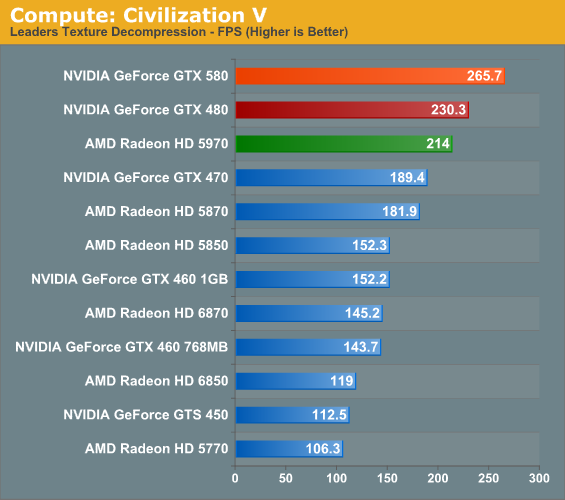
We previously discovered that NVIDIA did rather well in this test, so it shouldn’t come as a surprise that the GTX 580 does even better. Even without the benefits of architectural improvements, the GTX 580 still ends up pulling ahead of the GTX 480 by 15%. The GTX 580 also does well against the 5970 here, which does see a boost from CrossFire but ultimately falls short, showcasing why multi-GPU cards can be inconsistent at times.
Our second compute benchmark is Cyberlink’s MediaEspresso 6, the latest version of their GPU-accelerated video encoding suite. MediaEspresso 6 doesn’t currently utilize a common API, and instead has codepaths for both AMD’s APP (née Stream) and NVIDIA’s CUDA APIs, which gives us a chance to test each API with a common program bridging them. As we’ll see this doesn’t necessarily mean that MediaEspresso behaves similarly on both AMD and NVIDIA GPUs, but for MediaEspresso users it is what it is.
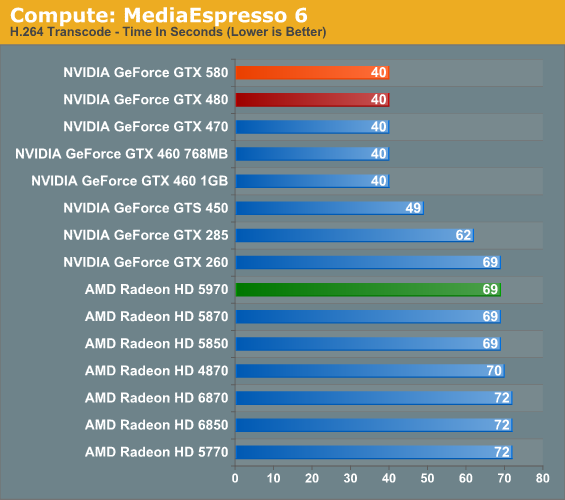
We throw MediaEspresso 6 in largely to showcase that not everything that’s GPU accelerated is GPU-bound, as ME6 showcases this nicely. Once we move away from sub-$150 GPUs, APIs and architecture become much more important than raw speed. The 580 is unable to differentiate itself from the 480 as a result.
Our third GPU compute benchmark is SmallLuxGPU, the GPU ray tracing branch of the open source LuxRender renderer. While it’s still in beta, SmallLuxGPU recently hit a milestone by implementing a complete ray tracing engine in OpenCL, allowing them to fully offload the process to the GPU. It’s this ray tracing engine we’re testing.
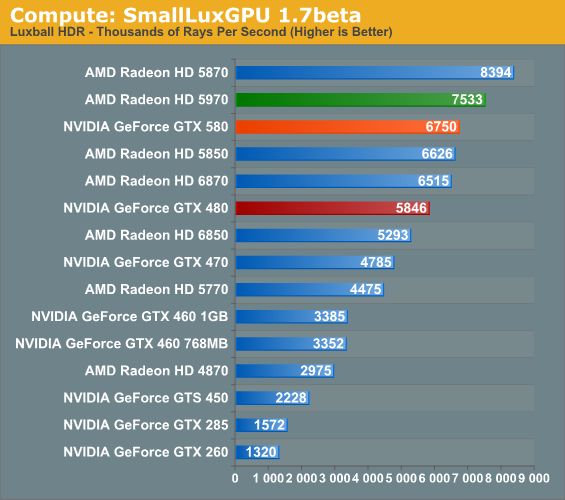
SmallLuxGPU is rather straightforward in its requirements: compute and lots of it. The GTX 580 attains most of its theoretical performance improvement here, coming in at a bit over 15% over the GTX 480. It does get bested by a couple of AMD’s GPUs however, a showcase of where AMD’s theoretical performance advantage in compute isn’t so theoretical.
Our final compute benchmark is a Folding @ Home benchmark. Given NVIDIA’s focus on compute for Fermi and in particular GF110 and GF100, cards such as the GTX 580 can be particularly interesting for distributed computing enthusiasts, who are usually looking for the fastest card in the coolest package. This benchmark is from the original GTX 480 launch, so this is likely the last time we’ll use it.
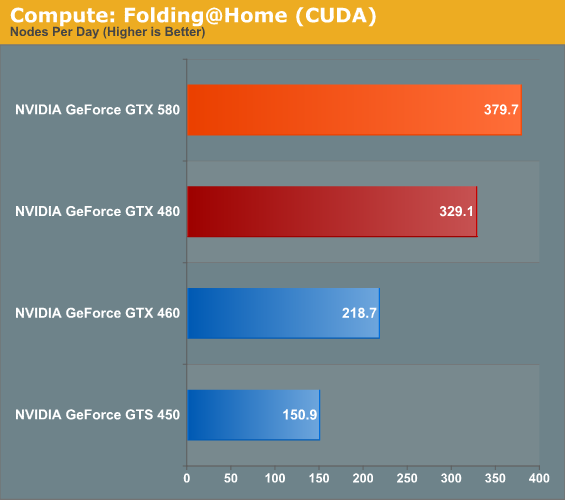
If I said the GTX 580 was 15% faster, would anyone be shocked? So long as we’re not CPU bound it seems, the GTX 580 is 15% faster through all of our compute benchmarks. This coupled with the GTX 580’s cooler/quieter design should make the card a very big deal for distributed computing enthusiasts.
At the other end of the spectrum from GPU computing performance is GPU tessellation performance, used exclusively for graphical purposes. Here we’re interesting in things from a theoretical architectural perspective, using the Unigine Heaven benchmark and Microsoft’s DirectX 11 Detail Tessellation sample program to measure the tessellation performance of a few of our cards.
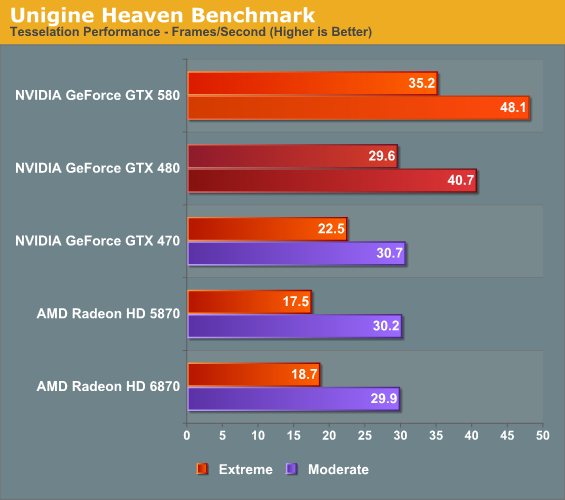
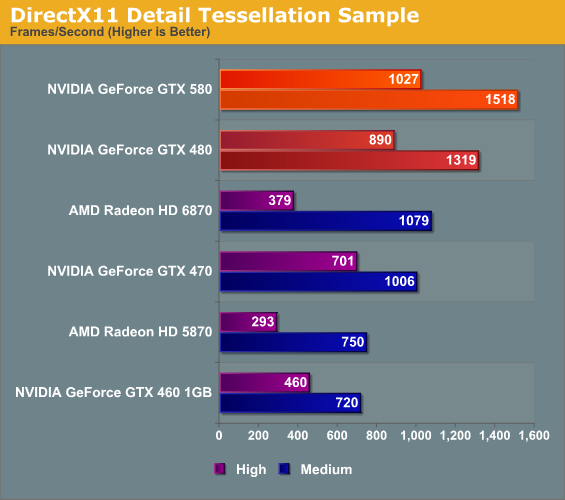
NVIDIA likes to heavily promote their tessellation performance advantage over AMD’s Cypress and Barts architectures, as it’s by far the single biggest difference between them and AMD. Not surprisingly the GTX 400/500 series does well here, and between those cards the GTX 580 enjoys a 15% advantage in the DX11 tessellation sample, while Heaven is a bit higher at 18% since Heaven is a full engine that can take advantage of the architectural improvements in GF110.
Seeing as how NVIDIA and AMD are still fighting about the importance of tessellation in both the company of developers and the public, these numbers shouldn’t be used as long range guidance. NVIDIA clearly has an advantage – getting developers to use additional tessellation in a meaningful manner is another matter entirely.










160 Comments
View All Comments
spigzone - Tuesday, November 9, 2010 - link
Any 'bandwagon' here belongs to Nvidia.mac2j - Tuesday, November 9, 2010 - link
Actually the new ATI naming makes a bit more sense.Its not a new die shrink but the 6xxx all do share some features not found at all in the 5xxx series such as Displayport 1.2 (which could become very important if 120 and 240Hz monitors ever catch on).
Also the Cayman 69xx parts are in fact a significantly original design relative to the 58xx parts.
Nvidia to me is the worst offender ... cause a 580 is just fully-enabled 480 with the noise and power problems fixed.
Sihastru - Tuesday, November 9, 2010 - link
If you think that stepping up the spec on the output ports warrants skipping a generation when naming your product, see that mini-HDMI port on the 580, that's HDMI 1.4 compliant... the requirements for 120Hz displays are met.The GF110 in not a GF100 with all the shaders enabled. It looks that way to the uninitiated. GF110 has much more in common with GF104.
GF110 has three types of tranzistors, graded by leakage, while the GF100 has just two. This gives you the ability to clock the core higher, while having a lower TDP. It is smaller in size then GF100 is, while maintaining the 40nm fab node. GTX580 has a power draw limitation system on the board, the GTX480 does not...
What else... support for full speed FP16 texture filtering which enhances performance in texture heavy applications. New tile formats which improve Z-cull efficiency...
So how does displayport 1.2 warrant the 68x0 name for AMD but the few changes above do not warrant the 5x0 name for nVidia?
I call BS.
Griswold - Wednesday, November 10, 2010 - link
I call your post bullshit.The 580 comes with the same old video engine as the GF100 - if it was so close to GF104, it would have that video engine and all the goodies and improvements it brings over the one in the 480 (and 580).
No, GT580 is a fixed GF100 and most of what you listed there supports that because it fixes what was broken with the 480. Thats all.
Sihastru - Wednesday, November 10, 2010 - link
I'm not sure what you mean... maybe you're right... but I'm not sure... If you're referring to bitstreaming support, just wait for a driver update, the hardware supports it.See: http://www.guru3d.com/article/geforce-gtx-580-revi...
"What is also good to mention is that HDMI audio has finally been solved. The stupid S/PDIF cable to connect a card to an audio codec, to retrieve sound over HDMI is gone. That also entails that NVIDIA is not bound to two channel LPCM or 5.1 channel DD/DTS for audio.
Passing on audio over the PCIe bus brings along enhanced support for multiple formats. So VP4 can now support 8 channel LPCM, lossless format DD+ and 6 channel AAC. Dolby TrueHD and DTS Master Audio bit streaming are not yet supported in software, yet in hardware they are (needs a driver update)."
NEVER rely just on one source of information.
Fine, if a more powerful card then the GTX480 can't be named the GTX580 then why is a lower performing then the HD5870 card is ok to be named HD6870... screw technology, screw refinements, talk numbers...
Whatever...
Ryan Smith - Wednesday, November 10, 2010 - link
To set the record straight, the hardware does not support full audio bitstreaming. I had NV themselves confirm this. It's only HDMI 1.4a video + the same audio formats that GTX 480 supported.B3an - Wednesday, November 10, 2010 - link
You can all argue all you want, but at the end of the day, for marketing reasons alone, NV really didn't have much of a choice but to name this card the 580 instead of 485 after ATI gave there cards the 6xxx series names. Which dont deserve a new series name either.chizow - Tuesday, November 9, 2010 - link
No ATI's new naming convention makes no sense at all. Their x870 designation has always been reserved for their Single-GPU Flagship part ever since the HD3870, and this naming convention has held true through both the HD4xxx and HD5xxxx series. But the 6870 clearly isn't the flagship of this generation, in fact, its slower than the 5870 while the 580 is clearly faster than the 480 in every aspect.To further complicate matters, ATI also launched the 5970 as a dual-GPU part, so single-GPU Cayman being a 6970 will be even more confusing and will also be undoubtedly slower than the 5970 in all titles that have working CF profiles.
If anything, Cayman should be 5890 and Barts should be 5860, but as we've seen from both caps, marketing names are often inconvenient and short-sighted when they are originally designated......
Galid - Tuesday, November 9, 2010 - link
We're getting into philosophy there. Know what's a sophism? An argument that seems strong but isn't because there's a fail in it. The new honda 2011 ain't necessarily better than the 2010 because it's newer.They name it differently because it's changed and wanna make you believe it's better but history proved it's not always the case. So the argument of newer generation means better is a false argument. Not everything new ''gotta'' be better in every way to live up to it's name.
But it's my opinion.
Galid - Tuesday, November 9, 2010 - link
It seems worse but that rebranding is all ok in my mind as it comes the 6870 comes in at a cheaper price than the 5870. So everyone can be happy about it. Nvidia did worse rebranding some of the 8xxx series into 9xxx chips for higher price but almost no change and no more performance. 9600gt comes to my mind...What is 9xxx series? a remake of a ''better'' 8xxx series. What is GTS3xx series, remake of GTx2xx, what is GTX5xx, .... and so on. Who cares? If it's priced well it's all ok. When I see someone going at staples to get a 9600gt at 80$ and I know I can get a 4850 for almost the same price, I say WTF!!!
GTX580 deserve the name they want to give it. Whoever tries to understand all that naming is up to him. But whoever wants to pay example 100$ for a card should get performance according to that and it seems more important than everything else to me!